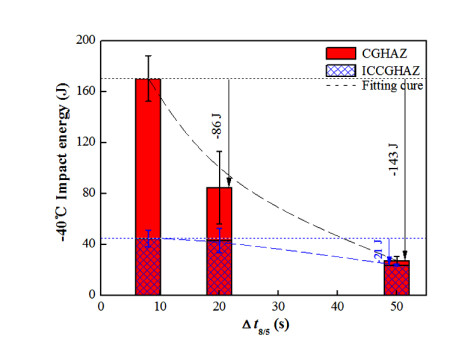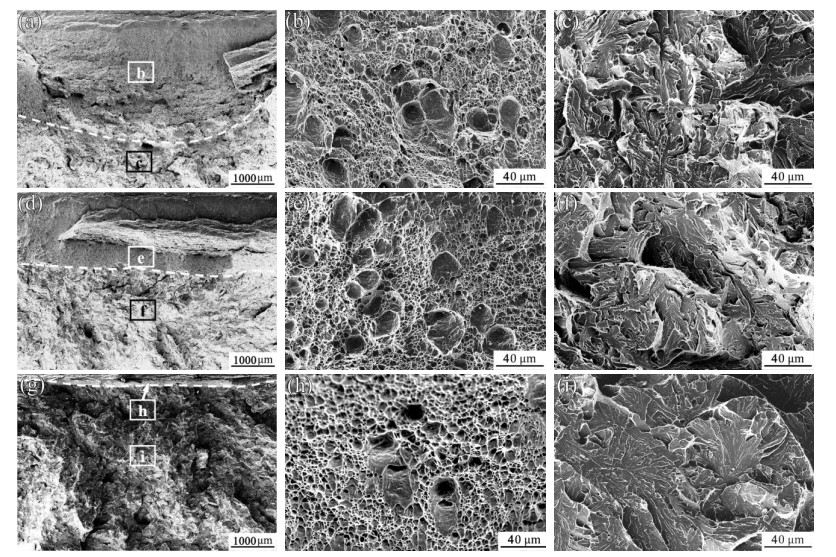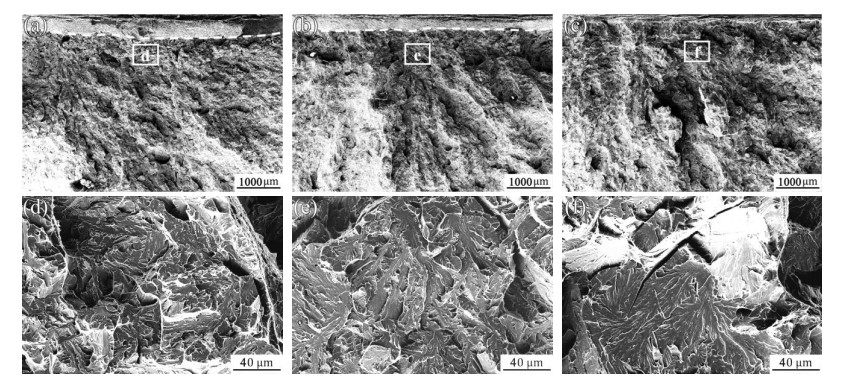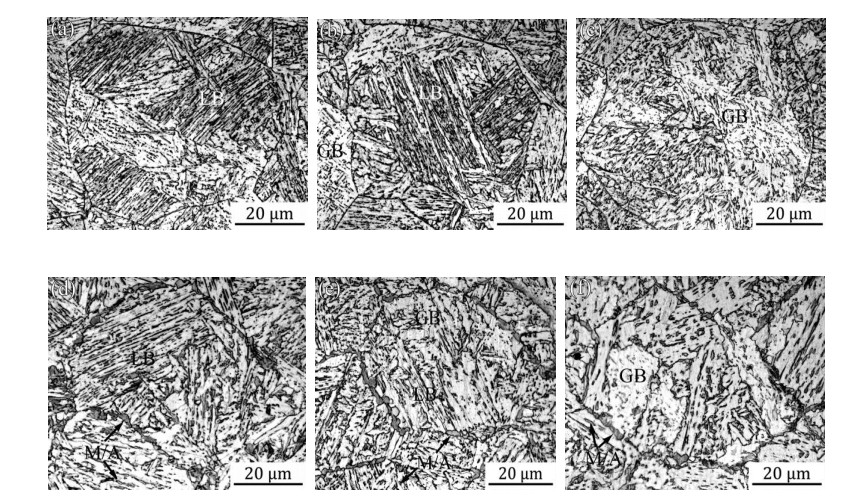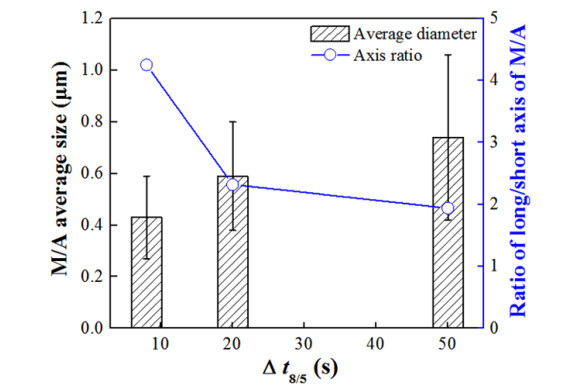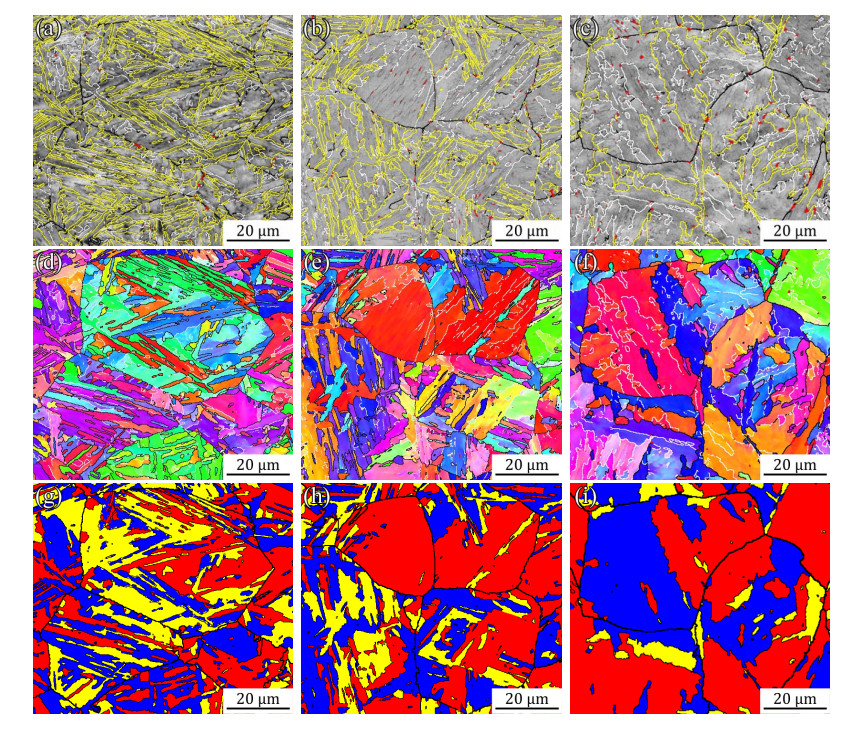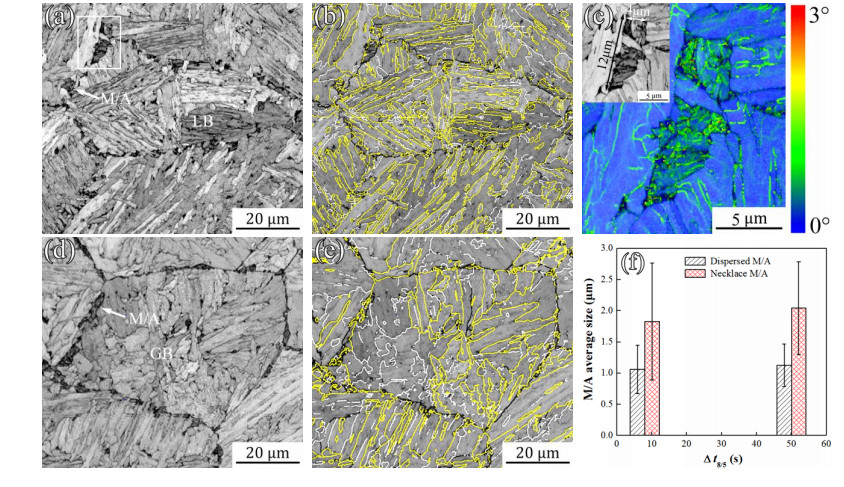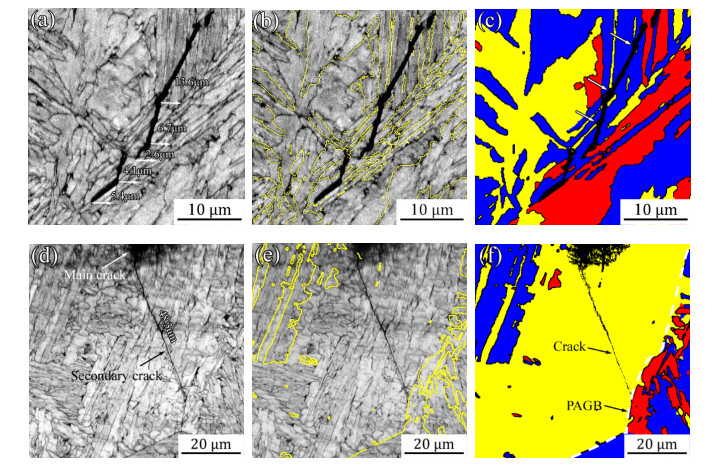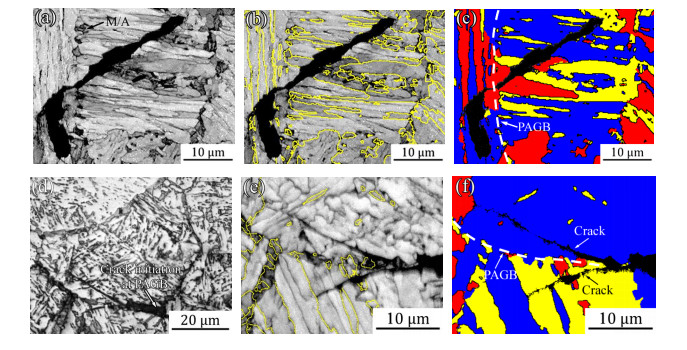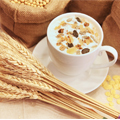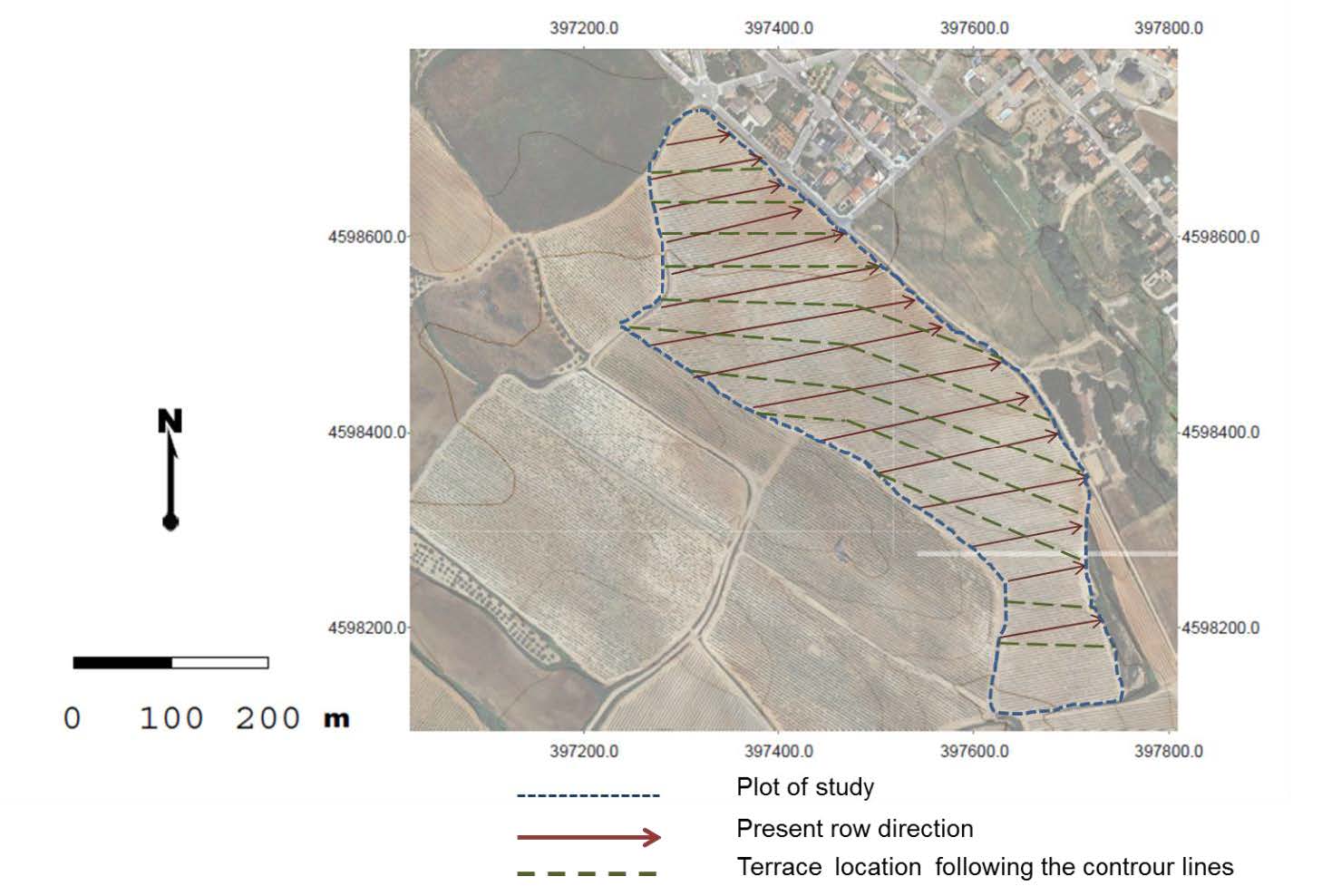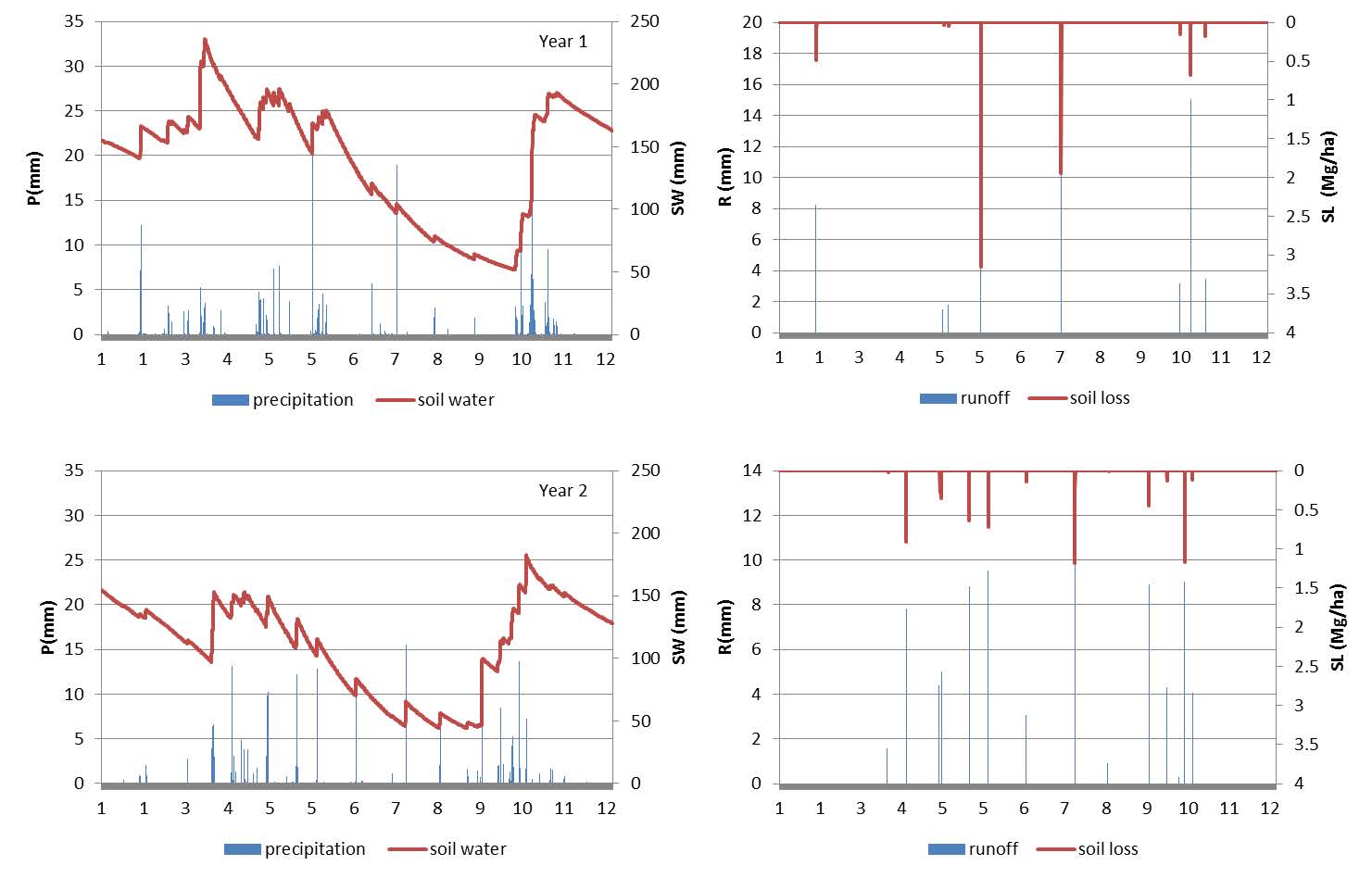Most vines in the Mediterranean are cultivated on bare soils, due to the scarcity of water. In addition, most traditional soil conservation measures have been eliminated to facilitate the movement of machinery in the fields. In such conditions, high erosion rates are recorded. Given the predicted changes in precipitation and an increasing number of extreme events, an increase in erosion processes is expected. In this study, erosion processes under different climate change scenarios were evaluated as well as the effects of implementing drainage terraces in vineyards. Soil losses were simulated using the WEPP model. The results confirmed the relevance of extreme events on annual soil losses. The WEPP model gave satisfactory results in predicting runoff and soil losses, although the soil losses recorded after some extreme events were under-predicted. The model responded to changes in precipitation and because of that a decrease in precipitation gave rise to a decrease in soil losses. For the scenario in 2050, runoff volumes decreased between 19.1 and 50.1%, while erosion rates decreased between 34 and 56%. However, the expected increase in rainfall intensity may contribute to higher erosion rates than at present. The construction of drainage terraces, perpendicular to the maximum slope, 3 m wide and 30 m between terraces, may lead to an average decrease in soil losses of about 45%.
1.
Introduction
Offshore engineering steels with high strength and good toughness have been widely used for construction of the marine structures. Meanwhile, the construction of steel structure has more stringent requirements for welding performance of the base material [1,2]. Since most of the offshore engineering steels are always processed into medium or heavy plates according to the requirements of actual construction, dual-pass and multi-pass welding are unavoidable. However, what comes simultaneously with these welding processes is the formation of heat affected zone (HAZ) adjacent to fusion line, which is often concluded as the most critical region with regard to potential failures, especially coarse grained HAZ (CGHAZ) and intercritically reheated CGHAZ (ICCGHAZ) which always exhibit the worst impact toughness [3,4].
Previous studies [5,6,7,8,9] issued that the most important concern in HAZ is impact toughness, and the critical factors that affect impact energy are M/A (martensite/austenite) constituents and high angle grain boundaries. The size, morphology and volume fraction of M/A constituents, as well as the density and inter-spacing of high angle grain boundaries are several key points to determine the impact energy. For CGHAZ, the formation of M/A constituents and high angle grain boundaries is primarily governed by cooling process, which can be controlled by regulating welding parameters, such as heat input. This has been studied systematically by You [9] and the others [10,11] and concluded that altering the heat input is by far the best way to obtain the optimum microstructure with fine M/A particles and high density of high angle grain boundaries, and good impact toughness. However, for ICCGHAZ, the frequently occurred necklace-type M/A constituents along prior austenite grain boundary has made it scarcely possible to regulate the toughness since they are particularly difficult to be controlled since they are formed in the second thermal cycle with peak temperature locating between Ac1 and Ac3 [3,12]. Moreover, these necklace-type M/A constituents with large size can enrich high carbon and increase cracking sensitivity, and thus change the fracture mechanism from nucleation-controlled to propagation-controlled [13,14,15], which will promote the propagation of cleavage fracture and thus dramatically reduce the impact toughness. Although, the singular role of M/A and high angle grain boundries on the impact toughness has been certified thoroughly, the combined effect of these two points are not elaborated clearly. Additionally, further investigation on whether precursor microstructure formed in CGHAZ has any positive effect on subsequent microstructure including necklace-type M/A constituents and impact toughness in ICCGHAZ is essential and unignorable.
Therefore, in the present study, the correlation between microstructure and impact toughness in CGHAZ and ICCGHAZ will be studied from both microstrucuctural morphology (M/A) and crystallography (grain boundary). Moreover, the combined effect of M/A and grain boundary on impact toughness, and the heredity effect of precursor microstructure on subsequent microstructure and impact toughness will also be discussed.
2.
Experimental
An E550 grade (yield strength: 550 MPa) offshore engineering steel with chemical composition (wt%) of Fe-0.06C-0.26Si-1.38Mn-0.65Ni-0.044Nb-0.4Cr-0.22Mo-0.35Cu-0.017Ti was employed in the present study. To obtain the microstructure and impact toughness of CGHAZ and ICCGHAZ, single and dual pass thermal simulation were carried out using Gleeble-3500. The simulated thermal cycles are presented in Figure 1. Three cooling rates through the temperature range from 800 to 500 ℃ corresponding to Δt8/5 time of 8 (fast cooling), 20 (medium cooling) and 50 (slow cooling) s were designed to obtain different bainitic structures in CGHAZ. For ICCGHAZ, the peak temperature of second pass was fixed at a middle temperature (780 ℃) between Ac1 and Ac3. After thermal simulation, standard impact specimens with the size of 10 mm × 10 mm × 55 mm were prepared to evaluate Charpy V-Notch (CVN) impact toughness at –40 ℃.
The microstructure of simulated samples etched with 4% nital was observed first by optical microscopy (OM). Fracture surfaces of the samples after Charpy impact tests and M/A morphology were characterized by scanning electron microscopy (SEM). Electron back-scattered diffraction (EBSD) in the SEM operated at 20 kV was used to study the changes in crystallographic features of bainite induced by cooling rate. Meanwhile, the correlation between crystallographic structure and crack propagation behavior was analyzed by using EBSD. Channel 5 software from Oxford-HKL and ARPGE software [16] were employed for post-processing original EBSD data.
3.
Results and discussion
3.1. Charpy impact toughness and fractographs
Figure 2 presents the results of Charpy impact toughness performed at –40 ℃ of the simulated CGHAZ and ICCGHAZ. It can be seen that the average impact energy of CGHAZ declines dramatically from 170 to 27 J with decrease of cooling rate from 37.5 to 6 ℃/s (increase of cooling time Δt8/5 from 8 to 50 s). Although similar tendency can be found in ICCGHAZ, the decrement is insignificant and only 21 J. Compared with CGHAZ and ICCGHAZ, it can be seen that excellent toughness (170 J) can be obtained in CGHAZ with high cooling rate, but for ICCGHAZ all Charpy values are lower than 45 J. That means the second thermal cycle with peak temperaute between Ac1 and Ac3 will deteriorate the toughness of prior CGHAZ. This result agreed with the previous stduy on impact toughness of HAZ in X100 pipeline steel [4], which suggested that the most vulnerable link usually occurs in ICCGHAZ and subsequently dominates the fracture behavior of the entire weldment.
Figures 3 and 4 show SEM images of the typical fracture surfaces of all simulated samples. The fracture surfaces shown in CGHAZ (Figure 3) consist of ductile and brittle manners, i.e. dimple and cleavage patterns. There is no visuable difference in morphology of dimple, but the area of ductile fracture region decreases observably with reduction of cooling rates. Moreover, the size of cleavage facets increases, especially as the cooling rate dropped to 6 ℃/s. These varieties in fracture surfaces are very consistent with the decrease in impact toughness. For ICCGHAZ (Figure 4), the fracture surfaces of all the three samples are dominant by cleavage patterns though small size of ductile region is formed as well in high and medium cooling rates, declaring poor toughness. Moreover, the tendencies changing in size of ductile region and cleavage facet are similar to CGHAZ, suggesting the effect of precursor microstructure on impact toughness of ICCGHAZ. Additionally, the reason of why the impact energies of ICCGHAZ with high and medium cooling rates are superior than CGHAZ with low cooling rate is attributed to the formation of larger size of ductile region and finer size of cleavage facet, which will be discussed in the viewpoint of microstructural evolution.
3.2. Microstructural analysis
3.2.1. Optical microstructure
Shown respectively in Figure 5 are the typical microstructures of simulated CGHAZ and ICCGHAZ, which display the characteristic of bainitic structures, i.e. lath bainite (LB) and granular bainite (GB). It can be seen that the microstructures of CGHAZ change from LB to a mixture of LB and GB, and then to full GB with decreasing in cooling rates. Similar results can be obtained in ICCGHAZ, while both of the lath and M/A particles formed in the matrix get coarser. Moreover, the most prominent is large necklace-type M/A constituents formed along prior austenite grain boundaries (PAGB). The above two differences between CGHAZ and ICCGHAZ in coarsen of matrix microstructure and formation of necaklace-type M/A constituents are due to the second thermal cycle process. Since the second peak temperature was located in two phase region (Ac1–Ac3), only part of the matrix microstructure obtained in CGHAZ was reverted to austenite [3]. The reversed austenite islands preferentially nucleated at PAGB and became enriched in carbon, and subsequently transformed to M/A particles during cooling, forming a "necklace" around the prior austenite grain. Moreover, the combined effect of coalescence, heredity and separation of the precursor microstructure that promoted the final microstructural morphology of ICCGHAZ was similar to CGHAZ, except for the size coarsening.
3.2.2. M/A and crystallographic structure in CGHAZ
Since M/A constituents in CGHAZ can not be plenarily characterized by OM, high-magnification SEM images are shot and shown in Figure 6. With the descend of cooling rate, two apparent differences can be found. One is the change in morphology of M/A constituent, and the other is the variation of average size. Although the average size displays an ascending trend, the values of all the three samples are smaller than 0.8 µ;m apart from the largest particles (~1.1 µ;m) displayed in Figure 7. Moreover, the volume fractions of M/A are only ~5.6 (Δt8/5 = 8 s), 7.2 (Δt8/5 = 20 s) and 7.7% (Δt8/5 = 50 s), respectively. That is to say that the shaping of the morphology should be more worthy of attention. From Figure 6a to c, it can be confirmed that the morphology of M/A constituent changes from film-shape to block-shape. Additionally, this variation can also be described from the aspect of ratio on long/short axis of M/A, as shown in Figure 7.
Previous study [17] suggested that M/A with thickness of ~20 nm could deflect brittle cracks and is good for impact toughness. Moreover, the critical size of M/A constituents that could deteriorate the impact toughness should be larger than ~1.3–2 µ;m [18], meaning that the M/A size in CGHAZ should not be the dominant factor that contribute to the variation of impact toughness. Since the crystallography is the most intrinsic aspect of the microstructure, the impact toughness would be partially affected by the crystallography. Therefore, the other influential factor, i.e. crystallographic structure was analyzed. Just as our previous study [19] and other works [20,21,22] proposed that the global change of the crack propagation path was mainly attributed to the boundaries of Bain zone, rather than by packet boundary. The Bain maps highlighted with three differential colors corresponding to three Bain groups were shown in Figure 8, together with boundary distribution maps and inverse pole figures (IPF) visualized the crystallographic structures. The boundaries with differential misorientation angles in boundary distribution maps are dispalyed correspondingly with different colors (misorientation: θ, white lines: 5° < θ < 15°, black lines: 15° < θ < 45°, yellow lines: θ > 45°), while for Bain maps the boundaries of Bain zone and prior austenite grain are respectively shown by black lines with misorientation angles larger than 45°. In inverse pole figures, the boundaries of crystallographic structures are displayed by low (white lines: 5° < θ < 15°) and high (black lines: θ > 15°) misorientation. The results suggested in the Boundary-Frequency distribution maps (Figures 8a–c and Figure 9a) indicated that the frequency of high angle grain boundaries (θ > 45°) decreases dramatically with the descending of cooling rate. Moreover, the morphology of Bain zones change from interleaved needle-like type to consolidated massive type, implying the variant selection policies varied. In the samples cooled with high rate, the driving force for bainite transformation are great as well. Since the cooling rate lowered, the driving force dropped simultaneously and subsequently promoted more variants from the same Bain group. Consequently, one or two predominant Bain zones are formed in a single austenite grain (red and blue Bain zones in Figure 8i) [23]. It means that the effective grain size becomes coarser, which can also be concluded from the size distribution and average diameters of Bain zones shown in Figure 9b. Figure 9c gives the actural density of high angle grain boundaries (defined with boundary length per unit area), which is consistent with the results of the size of Bain zones. The coarser the Bain zones, the lower the density of high angle grain boundaries. As the boundaries with misorientation between 15° and 45° are primarily prior austenite grain boundaries, there is no significant variation in these three values and the values are also small. Moreover, the decrement in density of low angle grain boundaries (θ < 15°) is due to the coarsen of bainitic lath, corresponding to the results of SEM. While, another interesting thing is the augment of the volume fraction of fcc phase i.e, reatined austenite (red dots in boundary distribution maps) with decreasing in cooling rate, which is similar to the change in M/A constituents. Previous study [24] showed that retained austenite as one part of M/A constituents can be obtained in room temperature, and the increasing tendency suggests the transformation that took place in higher cooling rate is much more complete than that in low cooling rate.
3.2.3. M/A and high angle grain boundary in ICCGHAZ
EBSD characterizations of ICCGHAZ with high and low cooling rates are shown in Figure 10. The evolution in density of grain boundaries is agreed with the results in CGHAZ. The similarities to the CGHAZ lie in two aspects. Firstly, in the samples cooled with high rates, high density of highly misoriented grain boundaries are formed. Secondly, the shaping of the crystallographic structure and the configuration manner of the differential Bain groups in both cases are analogous as well, implying the effect of precursor microstructural heredity is fascinating. The major difference emerged in ICCGHAZ and CGHAZ is the large amounts of necklace-shape M/A constituents formed along the prior austenite grain boundaries. The average size of necklace-shape M/A constituents can be up to 2 µ;m, which is much coarser than the dispersed M/A within the prior austenite grain. Moreover, the stress concentration in coarse M/A constituents is higher than that in bainite, meaning that a local brittle zone (LBZ) will be formed in ICCGHAZ, which in turn will bring about local unstable fracture [25,26] and seriously deteriorate the low temperature toughness of the entire weld joint. It should be noticed that there is no visible change in the size of necklace-type M/A or dispersed M/A with lower cooling rate. That means the variation of high angle grain boundaries should be account for the slight decline of impact toughness in ICCGHAZ, while the dramatic decline in toughness from CGHAZ to ICCGHAZ was due to the formation of necklace-type M/A constituents.
3.3. Correlation of crystallographic structure and crack propagation
It is well know that the impact toughness associated much to the abilities of crack initiation and propagation, which are primarily correlated to the brittle phase (M/A constituents) and crystallographic structure (high angle grain boundaries) in ICCGHAZ and CGHAZ. Therefore, the further investigations will focus on the crack initiation and propagation in the viewpoint of crystallography, considering the fact that the phase of microstructure is intrinsically crystal. EBSD images for the secondary cracks obtained from the fractured V-notch Charpy samples of CGHAZ and ICCGHAZ with high and low cooling rates are displayed in Figures 11 and 12. From Figure 11 it can be found that in different crystallographic structures induced by cooling rates, adverse crack propagation paths occurred. This diversity embodied in the size and morphology of the cracks (Figure 11a and d). Under high cooling condition, fine uniformly intersecting configured Bain zones that would form high angle grain boundaries were formed. They effectively deflected or arrested the brittle crack propagation and thus yielded multi-inflection cracks with short length, indicating more energies would be absorbed during crack propagation. In contrast, coarse Bain zones (yellow Bain zone in Figure 11f) that could easily provide a favorable path for crack propagation were formed at low cooling rate, and the crack would propagate throughout the entire Bain zone. It can be stopped only at the boundaries of Bain zone or prior austenite grain, resulting in a straight crack with large size and low absorbed energy. However, despite the size of Bain zones are quite differential, the configuration manner of the Bain zones are identical. Another finding is worth noting that the resistance of crack propagation or deflection angle seems to be related to the thickness of Bain zone, promoting a small angle to the direction of crack propagation. When the thickness is lower than a certain value, the resistance or deflection angle gets small, as shown by arrows in Figure 11c. Although another study [27] certified that the crack path in ferritic steel is related to the crystallographic misorientation between the neighboring grains when brittle cracks go through boundaries, and high angle grain boundaries in some particular cases could scarcely deflect or arrest the crack propagation, it has not been validated in bainitic steel. Moreover, the local change in crack path can also occur at these Bain zone boundaries, but nonlinear penetration. Therefore, we can conclude that the size of Bain zone could control the absorbed energy in process of cleavage fracture, though the size or misorientation effect is not very clear.
For ICCGHAZ (Figure 12), the patterns of crack propagation in samples with high or low cooling rates are the same as CGHAZ. Global or local changes in crack path simply occurred at the boundaries of Bain zone or prior austenite grain. While, the crack initiation at prior austenite grain boundary necklaced by coarse M/A constituents was observed in ICCGHAZ, as shown in Figure 12d. In the viewpoint of crack initiation from necklace-type M/A, four possible mechanisms are collated by Davis [5], which are (ⅰ) M/A particle is a brittle phase and cracks readily; (ⅱ) transformation to M/A induces residual tensile stress in the surrounding ferrite matrix which assists cleavage; (ⅲ) M/A with higher hardness than the surrounding ferrite will induce stress concentration in the neighboring ferrite matrix during external deformation, and thereby assists cleavage fracture; (ⅳ) micro-cracks forming on the debonded M/A and matrix interface propagate via the linking of other debonded regions. In this study, the crack initiated at necklace-type M/A constituents and then two micro-cracks branching from it were formed, indicating the fracture process should be obeyed the mechanism (ⅲ). This can also be verified by comparison the stress distribution in M/A particles (Figure 10c) and fracture morphology (Figure 4f). Moreover, comparing with the crack propagation and fracture surface, it can be believed that the obvious varieties in facets of the cleavage fracture region obtained at different cooling rates are attributed to the difference in crystallographic structure, i.e., the size of Bain zone.
3.4. Over-all discussion on correlation between microstructure and impact toughness
The above analysis on microstructural evolution and crack propagation in CGHAZ and ICCGHAZ suggested that the final impact energy of CGHAZ is primarily determined by the size of Bain zone enclosed by high angle grain boundaries and the M/A constituents, which is significantly influenced by cooling rate. The increase in hardenability caused by increased cooling rate promotes more crystallographic variants from different Bain groups. Meanwhile, combination with controlling inter-spacing of Bain zone boundaries by self-accommodation below the critical Griffith crack length, micro-crack can be arrested by these high angle grain boundaries and thereby suppressed the brittle fracture initiation and increased the ductile regions [28]. However, for ICCGHAZ, the impact energy is dominantly governed by M/A constituents, especially coarse necklace-type M/A constituents, and the influence caused by cooling rate is slight. That means the impact toughness of CGHAZ could be controlled more easily than the ICCGHAZ in terms of actual engineering, considering that the transformation of CGHAZ is more sensitive to the heat input than the ICCGHAZ during welding [9,10,11]. Since the ICCGHAZ was formed in the second welding thermal cycle and was unavoidable for dual-pass welding, it made it almost impossible for the ICCGHAZ to regulate the microstructure and toughness by changing welding parameters. The critical point is how to inhibit the formation of necklace-type M/A constituents or how to control the size and fraction once they were transformed. Previous studies [29] suggested that these necklace-type M/A constituents can also be formed in reheated zone of multi-pass weld metal. But fortunately, four feasible methods are also proposed in recent studies, which are (ⅰ) via increase of Ni in the matrix to promote the transformation of austenite more completely during welding and thus reduce the appearance of M/A constituents [24]; (ⅱ) through refinement of prior austenite grain size in CGHAZ to control the size of necklace-type M/A products formed in ICCGHAZ [16]; (ⅲ) by self-tempering in multi-pass welding process to decompose the formed necklace-type M/A constituents [29]; (ⅳ) through post-weld heat treatment, especially inter-critical heat treatment to promote the reversion of M/A constituents and formation of certain content of retained austenite by twice enrichment of Mn and Ni [30]. Although there exists some limitations in applying the above four methods such as cost growth, agammaessive control of welding process and application fields, it is indisputable that they can effectively control the formation and distribution of necklace-type M/A constituents and enhance the impact toughness.
Another technical route to control the properties from base plate to heat affected zone including CGHAZ and ICCGHAZ is using of niobium, despite that it has not yet been plenarily proved. The complex high-temperature (Ti, Nb)N-Nb(C, N) and strain-induced NbC precipitates were firstly obtained in hot rolled plate by precipitation. During welding, the fine NbC will be fleetly dissolved into the matrix, while coarse (Ti, Nb)N-Nb(C, N) particles with a given inter-spacing would be retained and thus exerts a larger Zener pinning pressure to prevent austenite grain coarsening, thereby resulting in a finer limited austenite grain size in CGHAZ [31,32]. Moreover, the soluted Nb can retard the austenite to ferrite transformation and facilitate bainite transformation to obtain an optimum crystallographic structure [33,34]. In the second welding thermal cycle, the finer austenite grain obtained in CGHAZ is beneficial to suppress the formation of coarse necklace-type M/A and consequently give a good toughness in ICCGHAZ [18].
4.
Conclusions
The level of the cooling rate effect on impact toughness in ICCGHAZ and CGHAZ is dramatic. Evident enhancement of toughness in CGHAZ can be achieved by increasing the cooling rate, whereas it is scarcely accessible for ICCGHAZ. It was due to that the kernel factor controlling the toughness of CGHAZ was crystallographic structures at differential cooling rates, while it transited to the necklace-type M/A constituents formed in the second thermal cycle and unconcerned to the precursor microstructure.
The slight increase in impact toughness in ICCGHAZ with increasing cooling rate is primarily attributed to the heredity of precursor microstructure. While, the reduction in impact toughness from CGHAZ to ICCGHAZ is due to the formation of necklace-type M/A constituents along the prior austenite grain boundaries.
The analyses on crystallographic feature and secondary crack propagation indicated that Bain zone should be confirmed as the effective grain from the crystallography, which can effectively deflect or arrest the brittle crack propagation. Coarse Bain zone will promote large and straight crack, resulting in large fracture facet and low absorbed energy. Moreover, the resistance of crack propagation yielded by over-fine Bain zone is slight because of the small angle of deflection in the direction of crack propagation.
Acknowledgement
The authors acknowledge the support from National Key Research and Development Project of China (2017YFB0304900), the China Scholarship Council (CSC) for the award of a scholarship to Xuelin Wang for studies at McMaster University, thanks to Glynis de Silveira and Chris Butcher in Canadian Centre for Electron Microscopy (CCEM) for the technical support with electron microscopy, and thanks to Cyril Cayron for the support of ARPGE software.
Conflict of interest
The authors declare that there is no conflict of interests regarding the publication of this paper.
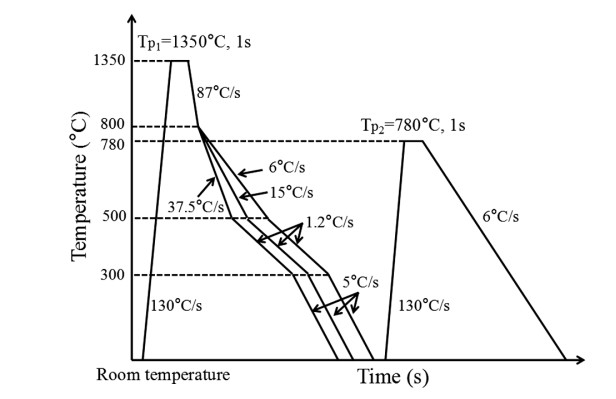









 DownLoad:
DownLoad:
